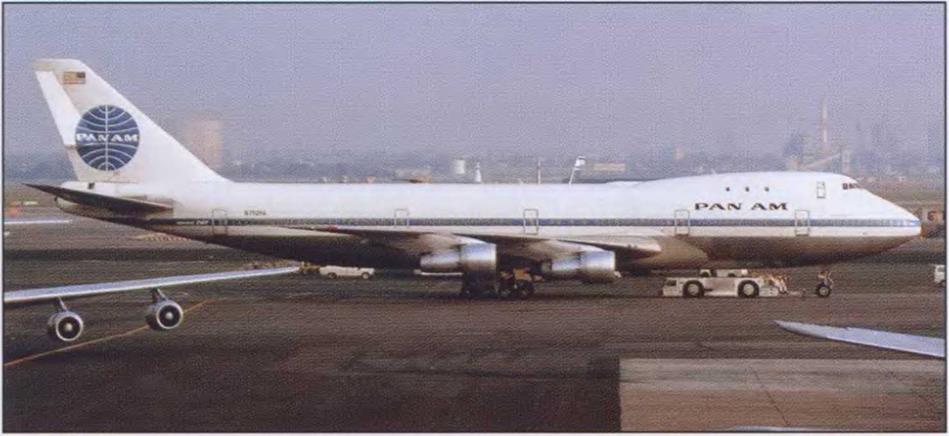Larger Jetliners in the late-1960s
Although public perception is that the Boeing 747 was the first airplane called a Jumbo Jet, that distinction technically goes to the McDonnell Douglas Super-60 family of advanced DC-8 jetliners. Douglas engineers at Long Beach created the world’s first 250-passenger airliner by adding more than 37 feet to the original DC-8 fuselage, and then developing three versions of this new larger airplane by combining different engine, engine pylon, and wingtip designs to meet various airline requirements.
The first stretched model, the DC-8-61, simply added a longer fuselage to the existing DC-8-55 wing and engines. The DC-8-63 became the “Cadillac of DC-8s” by combining the -61 fuselage with a longer wing, new “flow-through” nacelles for its uprated fan – jet engines, and sleeker “cut-back” pylons for improved aerodynamics and drag reduction. By shortening the new longer fuselage and utilizing the Series 63 wing and engine configuration, the DC-8-62 was born, offering such ultra-long-range routes as New York to Hawaii nonstop for the very first time. Flown by United, Delta, Eastern, and National, plus Braniff, Air Canada, and a host of international carriers, the DC-8 Super-60 series brought a new paradigm of lower seat-mile economics to airline operators and passengers alike, setting the stage for the next big step in airliner development.
Responding to a U. S. Air Force request to develop a new giant jet airlifter, Boeing, Lockheed, and Douglas pushed the envelope of aircraft construction to new heights with the CX-HLS Program. General Electric and Pratt & Whitney did likewise for powerplant development. Standing for “Cargo Experimental, Heavy Logistics Support,” this new mammoth aircraft was to be able to carry outsize loads on its main cargo deck, with accommodations for up to 90 passengers or relief crewmembers in compartments housed in an upper deck. A new generation of high-bypass turbofans would provide a then-staggering 25,000 pounds of thrust each to lift this beast into the air.
Although Lockheed won the CX-HLS contract with its C-5 Galaxy powered by General Electric
|
Ushering in the era of affordable air transportation for the masses, Boeing’s 747 entered service in 1970. The dream of Pan American’s Chairman, Juan Trippe, Pan Am and Boeing once again led the way to the next paradigm in commercial jet airliners, just as they did 12 years earlier with the Boeing 707. (Jon Proctor) |
engines, all five companies involved managed to parlay their newly acquired design expertise into the creation of giant new engines and airframes suitable for commercial passenger use.
First off the mark was Boeing with its impressive new 747 designed to the specifications of launch customer Pan American. More than 230 feet long and with a wingspan of 196 feet, this four-engine Goliath carried up to 400 passengers in mixed-class configuration with an exclusive upper-deck lounge located above the forward fuselage, accessible via a regal-looking spiral staircase. Entering passenger service in 1970, the 747 went through the inevitable teething problems for integrating so large an airplane into the existing air-travel infrastructure. It emerged, however, as a highly successful airliner that provided affordable air travel to the masses and drove the basic cost of flying down to unheard-of levels. With more than 1,400 produced to date, the 747 soldiers on as the pioneering design that helped create the new age of affordable international air travel we somewhat take for granted today.
McDonnell Douglas entered the commercial jumbo-jet sweepstakes by complementing rather than competing with the 747. Responding to the needs of American and United for a widebody jet that could operate out of smaller airports like New York’s LaGuardia, yet still carry 275 passengers on medium – to long-range stage lengths, McDonnell Douglas came up with a three-engine design called the DC-10. The new jetliner proved to be popular with the traveling public, but suffered a series of design-related accidents that tarnished the proud Douglas name. The DC-10 also became the Air Force’s newest tanker named the KC-10 Extender, of which 60 were built, in addition to the 446 commercial DC-lOs produced in Long Beach. Production ended with a follow-on design, a stretched, re-engined, glass-cockpit-equipped jetliner called the MD-11.
Last, but certainly not least in this trio of airliner titans was the Lockheed L-1 Oil. The only jumbo jet to officially have a name, the L-1011 carried on Lockheed’s stellar theme with the clever moniker TriStar. Considered a more advanced aircraft than the DC-10 from a systems standpoint, the TriStar was capable of Category III instrument landings and featured a center engine mounted in the aft fuselage fed by a streamlined S-duct air inlet. The L-1011 was ordered by TWA, Delta, Eastern, and Air Canada when McDonnell Douglas’ senior management refused to negotiate the price of its DC-10 for these same airlines. In so doing, McDonnell opened the door to intense competition from its cross-town rival. However, only 250 L-101 Is were built, and they were the last commercial aircraft produced by what is now the Lockheed Martin Company.











